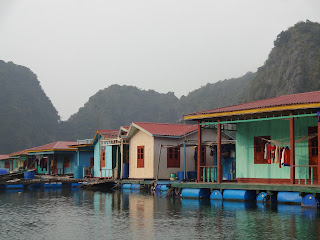Growing up, temples to me were Jewish houses of worship
where I went for Friday night services. Back then, I knew nothing about
Hinduism and Buddhism, but these days, I’m clear on the fact that temples come
in many flavours. Two of them are the focus at Siem Reap, Cambodia’s centre for
Hindu and Buddhist ruins, and what an amazing range there is to be found: small
and large, limestone and sandstone, dedicated to Vishnu or Shiva or Buddha,
reasonably intact or crumbling. All awesome in their individual ways.
I mentioned sunrise at Angkor Wat, the largest temple, in my
last post, but it is equally impressive during the day. The carvings on the walls tell tales of
Cambodian history and of Hindu mythology, and the visitor can follow along. The
towers offer views of the surrounding jungle, and there are still some
remaining statues of Buddha there to worship.
Although I knew very little about Angkor Wat and the other
temples when I arrived, an afternoon at the Angkor National Museum, a day with
a guide and some reading have brought me up to speed on the meaning and
symbolism. But there is also the sheer scale of the ruins at which to marvel!
Apparently, Angkor Wat was built with the help of hundreds of elephants hauling
blocks of limestone from mountain quarries, and there must have been thousands
of stone masons involved to build something so intricately decorated in only 37
years! Think pyramids and you’ll get the idea.
The Angkorian period in Cambodian history lasted from the 9th
century to the 13th and I also visited Angkor Thom, a city
constructed late in the period, that contained Bayon, a temple for the king, as
well as temples for the commoners. Bayon offers 216 faces looking out at the
visitor from four-sided heads – quite a daunting site, but wonderful!
And the
Tomb Raider temple was also on the agenda for the day. I envy Angelina Jolie
and her crew for having the entire place to themselves as they filmed. It must
have been magnificent; apparently, at night, it is home to thousands of small,
green parrots!
On the final day of my visit, I took a tuk-tuk (a motorcycle
pulling a cart with a seat in it) out to Banteay Srei, a temple 37 kilometres
away from temple central. It was worth the drive. The temple itself is a
marvel. It was created from red sandstone and done on a small scale, so it is
more or less human size. Its reliefs were carved more deeply than those at
Angkor Wat, and so many of them are intact! It was a gem of a place to
experience, and given the distance, there were few visitors.
The outing was also remarkable because it gave me a real
glimpse of the local countryside. It took me a while, as I passed shacks with
thatched roofs and shacks on stilts for use in the rainy season, to realize
what was so different: no electricity!!!!! That likely means no indoor plumbing
and no real kitchen facilities.
Houses had wood stacked up at the front, and I
saw people cooking at the side of the road. Women were making palm sugar candy
in huge bowls over coals, stirring and pouring it into moulds. Wow.
I was also lucky enough to catch a glimpse of traditional
fishing, using bamboo traps to cage a fish and pull it out of the river
shallows. Quite something.
Great food, too! I’ve discovered amok, a Khmer dish that is
so wonderfully spiced, it’s to die for. And their salads with fresh fruit and
meat/fish are also so different and flavourful. Yum.
It was a wonderful stop on my travel circuit, and the
Cambodian people were so warm and kind. It was a pleasure to talk with them and
earn a smile or two. Phnom Penh isn’t quite as welcoming, but that’s a story for
another day.

















































